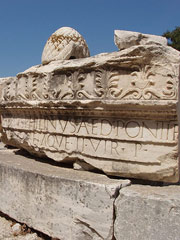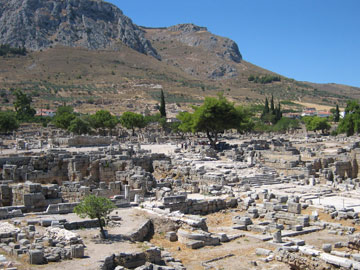
Ancient Agora of Corinth Engravings
One hundred years after the destroy of Corinth by the Romans Julius Caesar implemented a plan for the reconstruction of the cities that had been destroyed as he indented to send Romans for colonization over there. The first colonies of Corinth appeared in 44 BC. Ceasar was killed that year and the reconstruction of the town was taken over by Augustus.
The new town was called a settlement built by the “Julia family” and this was written on the coins. Apart from the Romans, Corinth was also inhabited by Greeks who had been set free by the Romans. Moreover, merchants, sailors and businessmen from east, in particular from Egypt, set their houses there. Latin was their formal language for a short time.
The fact that the Greeks were getting more and more resulted in the use of the greek language as well and gradually to quitting Latin entirely. The multicultural style of the town contributed to the existence of several religions which were allowed to be expressed freely, while one impacting on the other. The situation was similar for the two ports (Cechrea and Lechaio) where a lot of foreign merchant had settled. Several emperors and wealthy men were interested in embellishing Corinth, its ports and the surrounding areas of it during the 2nd and 3rd centuries AD. Eurecles was one of the first benefactors of Corinth as he sponsored the building of the baths while Babbius Philinus decorated the Agora with a round stone building.
Romans in Corinth

The Ancient Agora of Corinth
During the 1st century AD, Nero burnt the canal while Hadrian was interested in constructing an aqueduct and Herodes Atticus in embellishing the Agora of Corinth and the sanctuary of Poseidon. An early Christian community was created in Corinth and its ports and this resulted in the construction of several religious buildings such as Basilicas, especially at the ports.
During the 3rd century AD, Corinth had become a wealthy centre of the Roman state consequently it attracted a large number of Barbarians who invaded in the Roman prefectures. Justinian, in the 6th century AD, took care of the safety of Corinth and he built the Hexamilion Wall (six-mile wall) across the canal, which guarded the land path from the mainland to Peloponese. However he destroyed a lot of pre-Christian buildings in order to erase this wall, including Poseidon’s sanctuary. In any case, the functionality of the Hexamilion Wall was really ambiguous.
The position of Corinth
The geo-strategic importance of Acrocorinth made Corinth attractive to conquerors resulting to its domination by several occupants. Frank and Greek sovereigns ruled Corinth until 1458 when it was conquered by the Turks. In 1612 the Knights of Malta took it over from the Turks and in 1687 Venetians did so. During the Greek Revolution the Turks were occupying this area but did not manage to keep it due to the successful fights of the Greeks, so they were made to quit it in 1822.
What is more, during the Revolution War of Greece, there was a thought of making Corinth the capital of Greece, mainly thanks to its exceptional geographical position as it was located in the middle of the rebelled country. However, the glorious past and the ancient culture of Athens were much more important than the advantages of Corinth, so Athens became the capital of Greece in 1834. Corinth was destroyed by an earthquake that occurred in 1858 and the new city was rebuilt closer to the canal this time.
A new earthquake destroyed it once more in 1928 but its reconstruction started again very soon. Nowadays, Corinth is one of the prettiest cities of Greece and at the same time, the small village at the position of ancient Corinth has been reconstructed and keeps being embellished as well.
